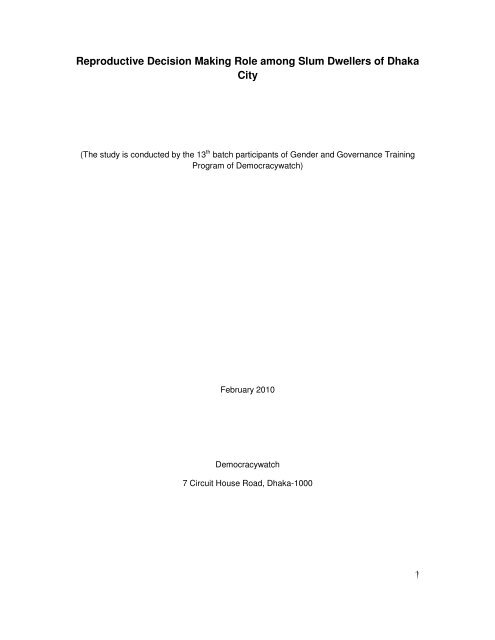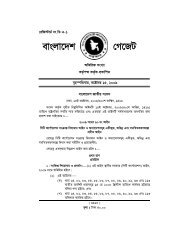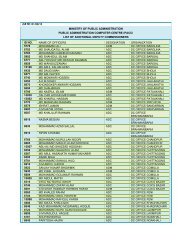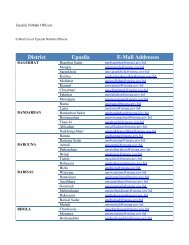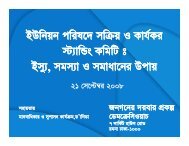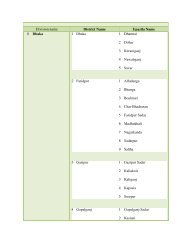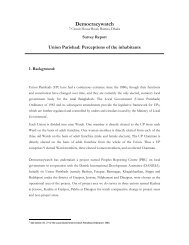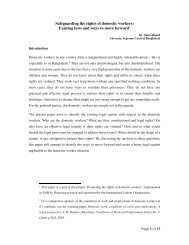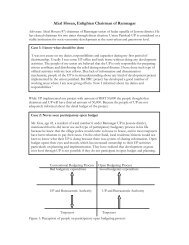Reproductive Decision Making Role among ... - Democracywatch
Reproductive Decision Making Role among ... - Democracywatch
Reproductive Decision Making Role among ... - Democracywatch
- No tags were found...
You also want an ePaper? Increase the reach of your titles
YUMPU automatically turns print PDFs into web optimized ePapers that Google loves.
<strong>Reproductive</strong> <strong>Decision</strong> <strong>Making</strong> <strong>Role</strong> <strong>among</strong> Slum Dwellers of DhakaCity(The study is conducted by the 13 th batch participants of Gender and Governance TrainingProgram of <strong>Democracywatch</strong>)February 2010<strong>Democracywatch</strong>7 Circuit House Road, Dhaka-1000
TABLE OF CONTENTChapter One1.1 Introduction1.2 Objectives of the study1.3 Rational of the study1.4 Definition of the terms usedChapter TwoReview of Related LiteratureChapter ThreeMethodology3.1 Study area3.2 Study Population3.3 Sample size & Sampling Method3.4 Data collection methods3.5 Data Collection Procedure3.6 Period of study3.7 Challenges and Limitations of the studyChapter FourData Analysis and RepresentationChapter FiveRecommendationsChapter SIXReferencesAnnexure I List of ParticipantsAnnexure II Questionnaire
CHAPTER: ONE1.1 INTRODUCTION:Bangladesh is one of the most densely populated countries in the world, with over 150million people squeezed into an area of 145,000 square-kilometers. There are nearly 920people per square kilometer 1 . With over 63 million of them (nearly half of the totalpopulation) struggling below the national poverty line (less than one dollar a day). Theaverage per capita income is just $440 per year. Although income poverty has fallen overthe past decade, from 58 per cent of the population to 49 per cent, the income disparitybetween rich and poor has widened. The country’s urban population continues to expandrapidly. Already, over 30 per cent of Bangladeshis live in urban areas. If it continues to growat current levels, Dhaka will become the second largest mega-city in the world by 2015, witha projected population of over 22 million (only Tokyo will be larger). The population of Dhakacity (areas under the jurisdiction of the Dhaka city corporation) stands at approximately7.0 million. The city, in combination with localities forming the wider metropolitan area, ishome to an estimated 12.8 million as of 2008 2 . The population is growing by an estimated4.2% per year, one of the highest rates <strong>among</strong>st Asian cities 3 . The continuing growth reflectsongoing migration from rural areas to the Dhaka urban region, which accounted for 60% ofthe city's growth in the 1960s ad 1970s. More recently, the city's population has also grownwith the expansion of city boundaries, a process that added more than a million people tothe city in the 1980s 4 . According to Far Eastern Economic Review, Dhaka will become ahome of 25 million people by the year 2025 5 .With urban population growth, the number of slums and the people who dwell in them arerapidly increasing. With an estimated 3.4 million people live in some 5000 slums of its capitalcity, Dhaka 6 . Dhaka is now experiencing a period of cramped population growth and slumdwellers are mainly responsible for this high growth rate. The population of Dhaka citydoubles in every 11 years whereas it takes 25 years to double the population for the wholecountry. The population of Dhaka city is now 99, 12,908 7 , and a report expects it to swell it to17.6 million up to 60% in the slums by the year 2010 and 25 million by the year 2025 8 ; andnearly equal to the current population size of the world's second largest urban1 BDHS Survey 20072 "Statistical Pocket Book, 2008", Bangladesh Bureau of Statistics3 McGee, Terry (2006-09-27). "Urbanization Takes on New Dimensions in Asia's Population Giants"Population Reference Bureau.4 Ibid5 Planet of Slums by Mike Davis6 Islam N. Slums of Bangladesh Mapping and Census Center for Urban Studies, 2005.7 Source: Bangladesh Population Census, 20018 Source: ADB Report, 1997
agglomeration, Sao Paulo, Brazil. At least 50 % of the urban population of Dhaka will beliving in slums 9 . Bangladesh's high rate of growth of slums and population living in slums hasserious economic, social, and public health consequences. Although the government has astructured health and family planning service delivery system for the rural poor, it does nothave any comparable infrastructure for the urban poor 10 . Nongovernmental organizations(NGOs) are the primary service providers for the urban poor population. However, somestudies report that "NGO services are often selective, less than optimum, and their coverageis incomplete" 11 .In 1990s the International Conference on Population and Development (1994), the UnitedNations Fourth Conference on Women (1995) and the Platform for Action (1995) advocatedintegrated approach towards health service, family planning and reproductive healthproblems of women. Considering the reality of a male dominated society where women haveless opportunity to exercise power in reproductive decisions, the PFA focused on women’shealth by including physical, mental, maternal and reproductive health and linked these withempowerment of women and the attainment of gender equality. According to the BeijingDeclaration (1995) “...........the explicit recognition and reaffirmation of the right of all womento control all aspects of their health, in particular their own fertility, is basic to theirempowerment.” It’s true that population control programs have a long history, relative to theconcept of reproductive rights, to work under the banner to improve the maternal and childhealth 12 , but it will be a mistake to explain the practice of family planning methods as anindication of women’s reproductive decision making power.In Bangladesh population control has been a declared government policy since mid sixties 13 .On the other hand in the early eighties women groups in western industrialized countries firstcoined the term reproductive rights. In countries like Bangladesh the use of the termreproductive right is very recent and thus the perception and practices of urban middle classare dominant in this discourse. But the practices, perspectives and perception of a largesegment who lived in informal settlements, are almost unexplored. In Bangladesh total slumpopulation is 5.4 million which is 35% of the aggregated population of 6 major cities-Dhaka,Chittagong, Khulna, Rajshahi, Sylhet ,Barisal 14 . Between 1995 and 2005 the total populationliving in slums of Dhaka has more than doubled 15 .The informal sector in urban areas is not yet fully urbanized. Those who live in the slums arelargely distressed migrants from rural areas, most of who live below the poverty line 16 , andmaintain the outlook and values of their rural heritage. They do not have sufficient access toeducation, employment, and health facilities of the formal sector to attain any higherstandard of living. As Haaga has observed, the health and nutritional status of the urban9 Barkat et al., 199610 Khuda et al, 199411 Jamil, Baqui, and Paijor, 199312 Brydon, Lynne and Chant, Sylvia; “Women in Third World: Gender Issues in Rural and UrbanAreas”; Edward Elgar Publishing Limited, England, 1993, p.19013 http://independent-bangladesh.com/news/feb/24/24022006wo.htm#A014 Haque, Iffat, “Urban Slum Mapping in Bangladesh” available at http://www.ciesin.columbia.edu15 Ibid16 Haaga, 1992
poor is even worse than that of the rural poor. Infant and maternal mortality rates are higherthan the national rates, and around one-third of the people in the slum communities arethought to be ill at any time. Also, more than 80 % of school-aged children in Dhaka slumsdo not attend school. All these factors are likely to adversely affect the contraceptivebehavior of those who live in the slums. These factors possibly also help to explain whyurbanization has had little effect on the declining fertility in Bangladesh.In 1994, the contraceptive prevalence rate (CPR) in slums was 40 %. This figure is muchlower than the national rate in urban areas of 54%, and lower than the national rate in ruralareas of 43% 17 . With this trend continuing, even if the family planning program achieves itstargeted objectives in the rural and urban formal sectors, the national CPR may not riseenough to attain the national goal of replacement level fertility (NRR=1) by 2005. Authors ofa recent national family planning strategic document suggested that, the government mustdevote special efforts as soon as possible to raise CPR in the slums in order to attain thenational goal within the stipulated period 18 . However, very little is currently known aboutreproductive behavior and family planning in the urban slums.<strong>Decision</strong> making capacity of a human being is one of those criteria which distinguish her/himfrom other species. Since it is related to intellectual ability to make the right choice and takeresponsibilities, recognizing the right of women to exercise decision making power alsorecognizes women as complete human being. But it is a historical fact that, women facemuch more challenges in accessing the decision making power just because of their sexualdifference.One of the most common health hazards of Bangladeshi women are the reproductive healthproblems which are indicated by the high maternal mortality rate (4.0 per 1000 live births).Fertility control like most other family decisions is not always an individual affair but involvesco-operation, discussion and joint decision making <strong>among</strong> couples. The nature ofrelationship existing <strong>among</strong> the couples affects the decision on family size. The status ofwomen in the family in particular and society in general is important in the decision authorityin the marital dyad. The way women interact with kins, neighbors, peers, and communityleader, health professionals’ etc. are significant extramarital influences in shaping thedecision style. Fertility decisions at a given time depend to a large extent on currentsituations within the family. Each birth may therefore be influenced by a different set ofmotivational, cultural and family conditions.A great number of barriers (for women) are rooted in social values, customs, beliefs andassumption about the nature of a woman and her capability. Males are generally referred toas the head of the home. These socially determined roles in the household have a significanteffect on decision-making that will determine ability to take advantage of opportunities thatwill then affect the educational, occupational, social and health-related status of members ofthe household along gender line. The social pressure to conform to the social elementsdetermining gender relationship is strong and deviation often carries a sanction, especiallyfor women.17 Barkat et al, 199518 Barkat et al, 1996
The congestion of living space, unhealthy environment and lack of health services make theurban poor vulnerable to health risk. Maternal and child health morbidities in slumcommunities which could have been easily prevented by providing basic health services andimproving access to water supply and sanitation services.1.2 Objectives of the study:The objectives of the study are to1. To know about the present status, powers and autonomy of women of slum dwellersregarding reproductive decision making.2. To find out their knowledge regarding reproductive health issues3. To determine the influence of socio economic background of the slum dwellers inreproductive decision making.4. To find out the causes those deter women from accessing and exercising decisionmaking power.5. To identify the way to remove the obstacles in the way of women’s decision makingpower and to ensure the right to freedom of choice.1.3 Rationale of the study:The growth rate of urban population is almost double than that of the rural population.People living in slums experience a staggering number of human rights violations. They areroutinely denied their right to adequate housing, safe water, sanitation and drainage,electricity, health and education, and face the constant threat of police and gang violence,and forced eviction. Slum residents pay disproportionately high rents because rent controllegislation is rarely imposed in areas considered by the authorities to be “un regularized”.Access to justice is denied because of discrimination and residents have no say in theupgrading of homes or services. The absence of health facilities and schools within manyslums severely restricts access to health care and education. Malnutrition and child mortalityrates in slums often match rural areas.A great number of barriers for women are related in social values, customs, belief andassumption about the nature of a women and her capability, Males are generally referred toas the head of the home. These socially determined roles in the household always havesignificant effect on reproductive decision making. The social pressure to confirm to thesocial elements determining gender relationship is strong and deviation often carries asanction especially for women.Slum dwellers are usually excluded from decision making processes that impact on theirlives and rarely enjoy full legal protection. The lack of security of residence and widespreadforced evictions sustain and deepen poverty deprivation <strong>among</strong> slum dwellers. Global slum
populations are growing at alarming rates. Disinvestment in rural areas, conflict, natural,disasters, climate change, forced evictions and corporate land grabbing continue to forcepeople to migrate to cities where affordable housing is scarce.The growth rate of urban population is almost double than that of the rural population.People living in slums experience a staggering number of human rights violations. This studywill help to know about the present reproductive decision making situation of slum dwellers.The absence of health facilities and schools within many slums severely restricts access tohealth care and education. Malnutrition and child mortality rates in slums often match ruralareas. Women are particularly vulnerable in slums, where lack of facilities place them atgreater risk of sexual assault and harassment and where the reporting of domestic violenceis often not treated seriously by police. Property law also frequently discriminates againstwomen.Health facilities are not adequate for the slum dwellers. As a result of this acute shortage ofhealth facilities most slum dwellers are either entirely left out of health services or receivevery poor quality health care. Because of the weak paying capacity <strong>among</strong> the slum people,even the private health care is also absent in the slums. The urban poor are forced to takealternative to unqualified health providers.Improving access to health services to the urban poor is a challenging for a variety ofreason. Urban health infrastructure in most cities is inadequate to meet the demands of largesections of the urban poor. Currently there is one Urban Health Centre for every 230,000persons as against the norm of one centre for every 50,000 population. As a result of thisacute shortage of health facilities most slum dwellers are either entirely left out of healthservices or receive very poor quality health care. Because of the weak paying capacity<strong>among</strong> the urban poor, even the private health care is also absent in the slums. The urbanpoor are forced to take alternative to unqualified health providers.Since family planning services are usually centered on women, it is required to find thatwhether they can take reproductive decisions without their husbands consent as thetraditional head of the home or not. So it is necessary to reshape the decision-makingenvironment in a way that would undermine the coercive patriarchal systems and createsconditions favorable to female autonomy, late marriages and smaller family size. In otherwords, the social context of sexual and reproductive decision-making should be wellexplored. Towards this end, it is vital that we have objective insight into the personal,household and social factors influencing fertility regulating behavior of individuals andcouples and on the basis of this suggest possible solution for problems of gender inequality,women empowerment and low fertility rate in the slum areas of Dhaka city. This workinvariably leads to new research questions and agenda that can enhance our knowledgeand understanding of the culture, power relationship <strong>among</strong> couples and how these affectsrole expectations, child bearing and rearing practices.This study will also help us to understand government health delivery system in slums,treatment seeking behavior for various reproductive morbidities (Gynecological, Obstetricand Contraceptive Morbidity) and discuss various homemade remedies women uses and
treatment seeking behavior is often influenced by a large number of factors apart fromknowledge and awareness.1.4 Definition of the concepts and terms:Slum:The slums have defined as a run-down area of a city characterized by substandard housingand squalor a densely populated temporary residential house built lawfully or unlawfullyhaving no water supply, sanitation facilities or electricity supply. Most of these are oneroomeddwellings and extremely over-crowdeddefined by the United Nations agency UN-HABITAT. The World Bank, in a survey report that was conducted in collaboration with theHousing and Settlement Directorate, Govt of Bangladesh and Centre for Urban Studies,defined a slum as a residential area where more than three hundred people live in one acre(0.405 hectors) of land. An average of more than three adults lives in a single room. 46percent of these houses are one-roomed and the average size is 120 square feet.Ventilation, drinking water, electricity and sewerage facilities are absent in these houses 19 .Slums can be divided into three groups Unauthorized occupation of government or semi-government lands Living in thatched houses made of papers, polythene, tin etc, built onunauthorized vacant land near railway lines or on the footpath or by side ofthe main roads. Living in unauthorised private lands.Again In a study by the Centre for Urban Studies et al. 2006, slums were defined asresidential areas characterized by the following conditions:1. Predominantly poor housing2. Very high population density and room crowding3. Very poor environmental services, particularly water and sanitation facilities4. Very low socioeconomic status for the majority of residents5. Lack of security of tenureAt present 1.5 million people live in slums within two or two and half miles radius of the city 20 .The living conditions of these slums are inhuman. There are no water supplies for drinking,bathing or cooking. Most of the dwellers have to spend daily Tk. 10-15 on average for buyingwater, which is unaffordable for many. Apart from this, there are few sanitation facilities. Inthe majority of slums, up to 20 - 100 families use one toilet and only on payment. The slumdwellers are also deprived of primary health care facilities. There is no medical centre forthem. The child death rate is unusually high, more than 15 per cent. Most of the childrensuffer from malnutrition.19 Source: ‘Dhakar Paribesh’, Gias Siddique, page- 4720 Ibid
Slum Dwellers:Although the characteristics of slum vary between geographic regions, they are usuallyinhabited by the very poor or socially disadvantaged and these people are called slumdwellers 21 .<strong>Reproductive</strong> decision making:The processes involved when women make decisions regarding reproductive behavior andhow the decisions made or the decision-making processes affect women’s self-image andtheir relationships with significant others--spouse, children (in case of both wanted andunwanted pregnancy) and members of the extended family is called <strong>Reproductive</strong> <strong>Decision</strong><strong>Making</strong>. The impact on self image is an important concern since empowerment of womenoccurs when they have a more positive self-image 22 .In this study, the decisions of taking child, choosing family planning methods, knowledgeabout family planning methods, number of children, role of the spouse during pregnancyperiod, problems faced for using contraceptive, health care facilities in postnatal andprenatal period, decisions of marriage are considered as indicators of productive decisionmaking.For this study we define <strong>Reproductive</strong> decision making to somewhat similar to that of the“Platform for Action”- the freedom and ability of couples and individuals to decide freely andresponsibly the number, spacing and timing of their children and to have the information andmeans to do so, and the right to attain a safe and standard sexual and reproductive health.21 Wikipedia22 Hong & Seltzer, 1994; Petchesky,1990; Worell & Remer, 1992
CHAPTER: TWOREVIEW OF RELATED LITERATURE:A study conducted by Mrs. Sabina Faiz Rashid, Assistant Professor of Brac University onEmerging Changes in <strong>Reproductive</strong> Behavior <strong>among</strong> Married Adolescent Girls in anUrban Slum in Dhaka, Bangladesh, published in <strong>Reproductive</strong> Health Matters, Volume 14,pages 151-159, dated May’06. This study came to an ending mentioning that, most of thewomen slum dwellers does not have power to take reproductive decisions independently.Either they depend on their husband or they are forced to obey their husband without sayinganything.Another publication from the same person heading “Small Power, Little Choice” was takenas our study material which was published on 2006 in the IDS Bulletin, Volume 37. Thisstudy found that, poor or extreme poor women from rural or urban area do not have anysexual security and they cannot practice their sexual rights. Thus, they are becomingvalueless in reproductive decision making role and turning into wooden dolls of their malepartners.Another study by Mrs. Sabina Faiz Rashid titled “Worried Lives: Gender & <strong>Reproductive</strong>Health for Adolescent Women in a Slum in Dhaka, Bangladesh” in 2003-04 reveals that,reproductive health situation <strong>among</strong> slum dwellers of Dhaka decreased in last ten years.Poor people came to Dhaka in last decade mainly in slum areas. Because of their povertyand unawareness, reproductive health situation has worsened. Several case study and indepth interviews have made our view clear on the decision making role of women <strong>among</strong>slum dwellers. Most of the women depend on their husband and cannot take their owndecision by themselves. Sometimes, they are forced to conceive babies y their husbands orfamily. Poverty ruins the treatment of their pre or post natal period. They do not have enoughmoney to feed themselves or their children.Another cross sectional study on “Unmet Need of Contraceptives <strong>among</strong> EligibleCouples of Urban Slum Dwellers in Dhaka” conducted by Dr. Shamsun Nahar, AssociateProfessor, National Institute of Preventive and Social Medicine, Mohakhali, Dhaka &Farhana Amin, Plan International, Bangladesh, published on Ibrahim Medical CollegeJournal 2009, 3(1): pages 24-28. A total of 265 married women of reproductive age fromKamrangir Char of Dhaka were taken as the sample of this study. This study found that,almost half of the poor women in those study area does aware of the Family PlanningMethod. Above forty percent of the sample size suffered or suffering from various types ofreproductive health related difficulties which can be very brutal to their lives.A study entitled “Determinant of Choices of Delivery Care in Some Urban Slums ofDhaka City” by Iftekhar Hossain & Md. Mainul Hoque, Department of Economics, Universityof Dhaka, published in Pakistan Journal of Social Sciences, 3(3), 2005, page no. 469-475,found that almost seventy percent of the poor family from urban slum in Dhaka have morethan five or six members and they do not show any interest in spending money on women in
pre-natal period or post natal period due to their poverty. The study also reveals that for awoman with a family size less than 5, the hospital utilization rate for delivery purposes is14%. Moreover as the family size increases, the home delivery incidents increase. We foundmore information from this study such as Information & Choice of Delivery, Reliance onTraditional System, Social Taboo and Belief, Access to Family Planning are also responsiblefor making reproductive decisions.From the findings of these studies, it is clear that the condition of reproductive decisionmaking role <strong>among</strong> slum dwellers of Dhaka City is so meager. Still in the twenty first centurymost of the women of the slum depend on their male partners regarding reproductivedecision. So that, we have taken our objectives and decided to work on <strong>Reproductive</strong><strong>Decision</strong> <strong>Making</strong> <strong>Role</strong> <strong>among</strong> Slum Dwellers of Dhaka City.
CHAPTER: THREERESEARCH METHODOLOGY3.1 Study Area:Due to mass rural to urban migration and urbanization and incorporation of erstwhile outlyingareas, growth of slums has been accelerated in Dhaka City, so that different slums selectedas the study area.3.2 Study Population:The study Population consisted of the slum dwellers of Dhaka city.3.3 Sample size and sampling method:Among the slums of Dhaka city, a representative sample of nine slums was selectedpurposively according to access facilities. Among the slum dwellers 361 respondentsselected using random sampling method to collect data, where 280 are female and 81 aremale.3.4 Data Collection Methods:Considering the nature of variables, numbers and types of respondents and their commentsquantitative procedures of data collection were applied.Data Collection Tools:Two types of data collection methods were used to conduct this study. These are:• Semi-structured interview schedule• Case Study3.5 Data collection procedure:The study was conducted on urban slum women and men to know about their knowledgeregarding reproductive health issues and to determine the influence of socio economicbackground of the slum dwellers in reproductive decision making.
A semi structured interview schedule was formulated for data collection. A rapport was builtwith the respondents. All questions were put in a conversation style. Respondents werecontacted by home visits. And case study also used to understand deeply to enhance ourknowledge and understanding of the culture, power relationship <strong>among</strong> couples and howthese affects role expectations, child bearing and rearing practices.To analyze the data, collected information was classified in the light of objectives set forth forthe study. The classified data was coded, tabulated and percent calculated for the same.The results were presented and discussed along with tables and graphs in numbers andpercentages.3.6 Period of Study: February-March, 20103.7 Limitations of the study:• As resources and manpower allocated for the proposed research was very limited, thedata collection was limited only within 361 respondents of Slum dwellers of Dhaka city.• Some respondents feel reluctant to answer the question regarding reproductive healthissues.• Some respondents do not want to say anything against husband being afraid ofviolence.
Second Chapter2.1 Findings from Survey2.1.1 Distribution of respondents according to study areas:SlStudy areas ( Slums)FemaleMaleFrequency % Frequency %1 Moghbazar Rail gate 68 24 21 262 Vashantek , Mirpur 44 16 18 223 Rajbari , Shia Masjid, Shaymoli 38 14 16 204 Baoniabadh , Mirpur 35 12 09 115 Segunbahgicha 28 10 04 056 Moga’s , Gulbagh 23 8 03 047 Khilgaon Bahgicha 19 7 03 048 Shukkur Mian’s, Baitul Aman,Shaymoli16 6 05 069 Paikpara, Ahmedabad, Mirpur 9 3 02 02Total 280 100 81 100Analysis:A total nine slum has been selected as study area from where 280 female respondents and81 male respondents were selected for interview. Distribution of respondents according toslums is presented in table 2. Sixty six percent female respondents and 79% malerespondents selected from slum areas of Moghbazar Rail gate, Vashantek - Mirpur, Rajbari -Shia Masjid, Baoniabadh- Mirpur
2.1.2 Age of the RespondentsSlAge LimitFemaleMaleFrequency % Frequency %1 16-20 82 11 04 52 21-25 70 25 10 123 26-30 46 29 21 264 31-35 31 17 16 205 36-40 31 11 11 146 41-45 9 03 05 067 45+ 11 04 14 17Total 280 100 81 100Analysis:Female respondents are mostly (71%) in the age group 21 to 35, where as 83% of the malerespondents age varies between 26 and 45 plus.2.1.3 Educational Qualifications:SlNo.EducationalQualificationFemaleMaleFrequency % Frequency %1 Illiterate 143 51 40 49Only sign name 18 06 03 042 Primary 82 29 23 283 Junior secondary 26 09 07 095 Secondary 5 02 07 096 Higher secondary 1 01 01 017 No information 5 02 -- --Total 280 100 81 100
Analysis:Among female respondents 57% are illiterate including 6% who can only sign their namesand <strong>among</strong> male respondents 53% are illiterate which is a little less than female respondent.Percentage of female and male respondents completed primary and junior secondary leveleducation is more or less same that is 38% and 37%. There is some difference <strong>among</strong>female (3%) and male respondent (10%) who have completed secondary and highersecondary level of education. This shows there is not much difference in education level ofmale and female in slum areas.2.1.4 Marital status:Sl.Marital statusFemaleMaleFrequency % frequency %1 Married 233 82 79 982 Separation 10 04 -- --3 Abandoned 22 08 -- --4 Widow/Widower 15 05 2 2Total 280 100 81 100Analysis:Majority (82%) of the female as well as male ((98%) respondents are married. Amongfemale respondents there are 12% who are separated or abandoned and 5% are widow.2.1.5 OccupationsFemale Respondents:Sl Occupation Frequency %1 House wife 114 412 Domestic worker 92 333 Small business 36 134 Day laborer 11 045 Garments worker 10 046 Cook 06 027 Handicrafts 06 028 Others 05 01
Total 280 100Male Respondents:SL Occupation Frequency (%)1. Small Business 18 232. Fish Business 03 043. Day labor 19 244. Garments Worker 02 025. Rickshaw puller 23 286. Thelagari driver 03 047. CNG Driver 03 048. Van Driver 01 019. Cook 02 0210. Tailor 01 0111. Unemployed 04 0512. Job 02 02Total 81 100Analysis:Among female respondents 41% respondents are housewife. Among working womensignificant number (35%) of women are engaged as domestic workers. In addition womenare engaged in small business (13%), day labor (4%), garments workers (4%), handicrafts(2%) etc.Among male respondents 37% are drivers of different type of transports such as CNG,rickshaw, cart and van. Twenty seven percent are engaged in small business and another24% are day laborers. In addition, there are two garment workers, one tailor and one cook.Five of the respondents are unemployed.Male respondents of the slum areas are occupied in economic activities which do not bringsufficient income for the family. As such, earnings of women, what ever small may be,supplements family income.
2.1.6 Number of Family Members:SlNumber FamilyMembersFemaleMaleFrequency % Frequency %1 5 and below 199 71 58 732 6-8 73 26 18 223 9 and above 08 03 05 05Total 280 100 81 100Analysis:Around three fourth of the respondents, both male and female, number of family membersranges from 5 and below. Similarly, around one fourth respondents, both male and female,mentioned that number of family members vary from six to eight. Only small number of 5 to 8has family members nine and above.2.1.7 Type of the Family (Female)Sl No. Family TypeFemaleMaleFrequency % Frequency %1 Nuclear 219 78 68 842 Joint 61 22 13 16Total 280 100 81 100Analysis:Majority of the families of both male (84%) and female (78%) respondents are nuclear.These nuclear families probably have small number of family members. As mentioned intable 2.1.6
2.1.8 Family income:Sl.Family incomeFemaleMaleFrequency % Frequency %1 1001 – 3000 70 25 7 092 3001 – 5000 70 25 31 383 5001 – 7000 69 24 30 374 7001 – 9000 25 09 10 125 9001 – 11000 11 04 13 046 11001 – 13000 02 01 -- --7 13000 + 06 028 No info 27 10 -- --Total 280 100 81 100Analysis:Majority (74%) of female respondent’s family income ranges from taka 1,001 to taka 7,000.However, majority (87%) of male respondents’ family income ranges from Taka 3001 toTaka 9000. This is higher than the income range of female respondents. However, range ofincome of some female respondents goes up to Taka 13,000 and above. Only six femalerespondent’s family income goes up to 13,000 and above. Among these respondents, twoare housewife. That indicates that their husband or other family members are involved insome profitable business or occupation. Among the four respondents, three mentioned thattheir husband has small business. Only one respondent is widow with four sons. All of hersons are involve in grocery business.
2.1.9 Age of marriage (female):Sl.Age of marriageFemaleMalefrequency % frequency %1 10 – 12 46 16 -- --2 13 – 15 106 38 01 013 16 – 18 86 31 10 124 19 – 21 38 13 22 285 22 – 24 01 01 22 286 25 – 27 03 01 19 237. 28-30 -- -- 06 078 30+ -- -- 01 01Total 280 100 81 100Analysis:Child marriage was very much prevalent <strong>among</strong> the female respondents. Eighty five percentof the female respondents got married on or before 18 years and below. Even <strong>among</strong> malerespondents11 of them got married at an early age. However, most (79%) of the men gotmarried between the age 19 to 27.2.1.10 Consent of marriage:Sl.Consent of marriageFemaleMalefrequency % frequency %1 Yes 151 54 70 87
2 No 47 17 06 073 Guardian 68 24 05 064 Other * 12 04 -- --5 No comments 02 01 -- --280 100 81 100* (Others included elder brother, uncle, relatives.)Analysis:More than half (54%) of the female respondents mentioned that their consent was takenduring negotiation of the marriage. Forty five percent respondents mentioned that theirguardians, relatives fixed their marriage without discussing with them and customaryconsent was taken during marriage ceremony. In case of male respondents 87% reportedthat their consent was taken during arrangement of marriage and in 13% cases guardianstook the decisions and since they did not have any objection they did not protest.2.1.11 Women respondents’ knowledge about legal age of marriage (18 years)SlKnowledge about legal ageof marriage (18 years)Frequency Percentages (%)1 Yes 238 852 No 42 15Total 280 100Analysis:Although majority (85%) of the respondents mentioned that they know that legal age ofmarriage which is 18 years and above, but because of circumstances a large number gotmarried at an early age.2.1.12 Number of children:Sl.No. of childrenFemaleMalefrequency % frequency %1 0 04 01 -- --2 1 – 2 142 51 40 49
Analysis:Among 68 male respondents 55 (81%) have at least one son and out of 64, 69% have atleast one daughter. (How many male respondents have both son and daughter?? How manyof them want more children???)2.1.15 Age of having first child (female)Sl.Age of having first childFemaleMalefrequency % frequency %1 12 – 14 34 12 7 92 15 – 17 100 36 24 303 18 – 20 102 37 36 454 21 – 23 34 12 9 115 24 – 26 06 02 4 56 27 – 29 03 01 -- --Total 279* 80* 100*One male respondent does not have any child.*One female respondent is pregnantAnalysis:Among 280 respondents, nearly half (48%) of them had first issue at the age of 12 – 17years and another 37% had first issue at the age of 18-20 years. Similarly, 39% cases wivesof male respondents had first issue at the age of 12 – 17 years and another 45% cases hadfirst issue at the age of 18-20 years. These findings coincide with their marriage age. Eightyfive percent of female respondents were married at an early age.2.1.16 <strong>Decision</strong> to have 1 st child:Female Respondents:SlNo.Whose decision Frequency Percentage
1 Both 161 582 Husband 59 213 Without planning 27 104 Herself 18 065 Family 11 046 Others 4 01Total 280 100Analysis:Two third (64%) of the respondents mentioned that respondents themselves along with theirhusband decided to have children. Twenty six percent reported that their decision wasinfluenced by their husband and family members.Male RespondentsSl <strong>Decision</strong> Frequency Percentage1 Both 53 662 Self 22 273 Didn’t Understand 2 34 Wife 1 15 Family <strong>Decision</strong> 1 16 Others 1 1Total 81 100Analysis:Two third (66%) of the respondents’ mentioned that decision of having first child was takenby both husband and wife together. Twenty seven percent respondents mentioned thatdecision of having first child was their (husband) decision. Two respondents are of theopinion that it is customary that after marriage a couple will have child and were confusedwith the question of discussion and decision.2.1.17. The decision of taking more than one child. (FEMALE)
Sl Whose decision Frequency Percentage1 Both 124 442 Husband 62 223 Without planning 36 134 Herself 24 095 Family 22 086 Others 12 04Total 280 100Analysis:Nearly half (53%) of the respondents mentioned that respondents themselves along withtheir husband decided to have more than one child. 22% respondents reported that takingmore than one child was their husband’s decision.Findings of above tables 2.1.16 and 2.1.17 indicate that women are gradually taking part inreproductive decision making.2.1.18. The role played by husband in pregnancy period.Female response:Sl <strong>Role</strong> of husband Frequency Percentage1 Indifferent 101 342 Looked after the wife bysupporting medical care,nutritious food, assisting inhousehold work, taking care ofother children etc181 603 Took some care 13 044 No comment 5 02Total (*multiple response) 300 100Male response:Sl <strong>Role</strong> Frequency Percentage
1 Did not play any role 19 242 Looked after the wife by supportingmedical care, nutritious food, assistingin household work, taking care of otherchildren etc77 76Total (*multiple response) 96 100Analysis:It is encouraging to find that 60% cases husbands provided various support to their wivesduring pregnancy, such as medical care, arranged for nutritious food, assisted in householdwork, took care of other children etc. Another 13 respondents mentioned that their husbandstook some care. One third (36%) of the respondents reported that their husbands wereindifferent during the time of their pregnancy.Among the male respondents, majority (76%) said they looked after their wives whichincludes supported in medical care, nutritious food, assisted in household work, took care ofother children etc. Only 19 respondents reported that they did not pay attention during theirwife’s pregnancy period.Although, there are cases where husbands were indifferent and did not took care of theirwives during pregnancy, It is a positive sign that in large number of cases husbands lookedafter their wives during pregnancy.2.1.19. Provision of Healthcare facilities in pregnancy period:Slhealthcare in pregnancy periodFemaleMaleFrequency % Frequency %1 Yes 183 65 60 742 No 97 35 21 26Total 280 100 81 100Analysis:Around two third (65%) of the female respondents mentioned that they were providedhealthcare facilities during pregnancy period and 74% male respondents said that theirwives received medical care as and when needed.2.1.20. Persons/institutions from where health care received.
Sl Persons/institutions from wherehealth care received.FemaleMaleFrequency % Frequency %1 Health worker 58 27 25 382 NGO clinic 56 26 21 323 Hospital 48 23 9 144 Surjer hasi 26 12 6 95 Local /traditional doctor 5 03 1 26 Others 20 09 3 5Total 213 100 65 100Analysis:Among 280 female respondents, 213 (76%) women mentioned that they have receivedhealthcare services from various healthcare institutions. Most (88%) of them avail services ofhealth workers, NGO clinic, hospital, surjer hasi and only 3% from traditional doctors.Out of 81 male respondents 65 (80%) cases their wives received health care from varioushealth institutions during pregnancy. As mentioned by female respondents, wives of malerespondents mostly (84%) availed services of health workers, NGO clinic, hospital, andsurjer hasi2.1.21. Birth place of the childrenSerialBirthplace of childFemaleMaleFrequency % Frequency %1 At home 244 84 70 852 At hospital 41 14 11 133 Others 5 2 02 02Total (*multiple response) 290 100 83 100Analysis:Although most of the female respondents and wives of male respondents availed pre-natalcare from recognized health care services, majority of both male (85%) and female (84%)respondents mentioned that their children were born at their home; their mother’s place or
elatives place. Only 52 cases reported that they went to hospital for delivery. Generally,normal delivery takes place at home and complicated cases are taken to hospital fordelivery.2.1.22. <strong>Decision</strong> of child’s birthplaceSlWhose decisionFemaleMaleFrequency % Frequency %1 Family 86 31 14 172 Husband 84 30 35 443 Wife 74 26 2 024 Both husband &wife32 11 24 305 Others 4 02 6 07Total 280 100 81 100Analysis:37% female respondents reported that herself or jointly with husband decided the birthplaceof their children. Around two third (61%) of the respondents reported that husband andfamily members decided the birthplace. Similarly, in case of male respondents 61% casesdecision was taken by the husband or other family members and 32% cases wife individuallyor jointly with husband took the decision. (Contradictory to family type which is mostlynuclear. May be people who were looking after the would be mother and husband jointlytook the decision)2.1.23. Birth attendant
SlBirth attendantFemaleMaleFrequency % Frequency %1 Unskilled midwife 145 52 44 562 Relatives 63 23 17 223 Health assistant 10 04 05 064 Trained T.B.A 46 16 10 135 Others* 15 05 02 03279 100 78 100• Others also mean herself and relatives.• By “herself” means – One respondent named Sakhina Khatun, lived in Baunia BadhSlum. She mentioned that at her labor time there was no one to help her, not evenher husband or relative or neighbor. At that time she was at her place. She gave birthto her child in the house without any help of any one.Analysis:Among 279 female respondents, 80% were attended during delivery by unskilled midwives,untrained relatives or her. 20% respondents’ were attended by health assistant and trainedT.B.As. Similarly, wives of the male respondents were also in majority cases (78%) attendedby unskilled midwives and relatives during delivery.2.1.24. Incidence of abortion:Sl Incidence ofabortionFemaleMaleFrequency % Frequency %1 Yes 37 13 15 192 No 242 87 66 81Total 279* 100 81 100N.B: 1. One respondent is carrying baby who was not counted in the total number of femalerespondents.Analysis:Among 279 female respondents, 13% mentioned that they had abortion of the child and incase of male respondents 19% male respondents’ wives had abortion.
2.1.25. <strong>Decision</strong> for abortion (Female)Sl<strong>Decision</strong> of abortionFemaleFrequency %1 Miscarriage 15* 402 Self decision 6 163 From husband’s decision 8 224 Both of them together 1 035 Family members 3 086 Others 4 11Total 37 100* one respondent had abortion due to physical torture by her husbandAnalysis:Among 37 female respondents, 40% respondents mentioned that they had miscarriage.According to them it was like “Batash laga”. Nineteen percent cases it was their owndecision or jointly with their husband. 22% mentioned that the decision have been taken bytheir husband and 8% respondents mentioned that the decision have been taken by theirfamily members. Others include as advised by the doctor2.1.26. Postnatal health care of the respondents; Female/ Male respondents’ wivesSlPostnatal health careFemaleMaleFrequency %) Frequency %1 Yes 174 62 69 852 No 106 38 12 15Total 280 100 81 100Analysis:Nearly two third (62%) of the female respondents and 85% of the male respondentsmentioned that their wives availed postnatal care. It is surprising that so many femalerespondents and wives of male respondents availed postnatal care which is far abovenational figure which is 33%.2.1.27. <strong>Role</strong> of husband during post natal period. (Female)
Sl <strong>Role</strong> of Husband Frequency Percentage1 Satisfactory 170 982 Had no comment 03 2Total 173 100Analysis:Total 173 respondents’ reported about their husband’s role during post natal period. Most(98%)of them reported that their husband’s role was satisfactory which includes supportedin medical care, nutritious food, assisted in household work, took care of other children etc.Only 03 respondents reported that they had no comment.2.1.28. State of the respondents practice on family planningSlState of family planningpracticeFemaleMaleFrequency % Frequency %1 Yes 170 61 16 202 No 101 36 65 803 Followed before 9 04 -- --Total 280 100 81 100Analysis:Around two third (65%) respondents mentioned that they have been practicing familyplanning or practiced before and 36% are not practicing. On the other hand in case of malerespondents majority (80%) of them does not practice family planning themselves (may betheir wife use fp ), Rest of them (20%) practice family planning.2.1.29. Family planning methods used by the respondentsFemaleSL Family Planning Methods* Frequency Percentage
1 Pill 84 412 Birth control injection 107 533 Ligation 8 48 IUD 4 2Total 203 100* Multiple responsesMaleSL Name of materials Frequency Percentage3 Permanent 03 196 Temporary 13 81Total 16 100Analysis:Among 179 female respondents, some of them used more than one method. 53% used birthcontrol injection which is followed by 41% who takes birth control pill. Four of them havetaken IUD and only eight of them used permanent method i.e. ligation.Among 16 male respondents, 81% adopted temporary methods and 19% take on permanentmethod. i.e. vasectomy.2.1.30. Reason behind not using family planning methodsSlReasons behind not usingfamily planningFemaleMaleFrequency % Frequency %1 Ignorance/ No idea 10 14 3 52 Resistance of husband 16 233 Religious prejudice 16 23 3 54 Methods are used by husband/wife4 6 47 725 Husband absent 14 20 - -6 Physical problem 6 8 - -
No plan to adopt FP - 4 6Want more children - 2 37 Want to use in future 4 6Others - 6* 99 No response 21Total 91 100 65 100(Others – do not feel necessary, respondent got married twice for children, do not believe inthese methods, boy child expectancy, it will decrease the value of masculinity)Analysis:Female respondents reported various reasons for not practicing family planning. These areignorance about family planning (14%), resistance of husband (23%), religious prejudice(23%), absence of husband (20%), physical problem (8%), methods used by husband (6%)etc. However, four respondents said that they want to practice Family planning in future(6%).In most (72%) cases the male respondents reported that they are not practicing familyplanning, usually their wives practice family planning, most common phenomena. Otherreasons for not practicing family planning according to the male respondents are ignoranceabout family planning (5%); religious prejudice (5%), want more children (3%), others (9%).A very interesting finding come out from the study is that only <strong>among</strong> the male respondentssix percents said that they have no plan to adopt Family planning.2.1. 31.Sources of receiving information about family planningSLSources of info on FP*FemaleMaleFrequency % Frequency %1 Newspaper 2 1 - -2 TV 38 14 17 213 Radio 5 2 04 054 Relatives/friends/neighbors 129 46 29 365 Health worker 167 60 49 606 Poster/ billboard 7 2 04 057 Community functions 2 1 01 01
8 NGO Clinic (Marie Stopes) - - 03 049 Hospitals - - 01 0110 No info 05 0611 Others 13 5Total 363 113* Multiple responses.Analysis:Since women generally stay at home, they have access to information delivered at homesuch as health workers (60%), relative, friend, neighbor (46%) and TV, Radio and newspaper ((17%). In case of male also source of information is mainly health workers (60%),relatives/friends/neighbors (36%) and TV, Radio (26%). Since men go out they also haveaccess to information from community functions, posters and bill boards, NGO clinics andhospitals. Since family planning is still considered an issue not to be consulted in public,source of information delivered at home is more effective. <strong>Role</strong> of health workers andrelatives/ friends/neighbors is prominent in getting Family Planning information.2.1.32. Preference of decision on using family planning methods (Female)Sl <strong>Decision</strong> Frequency Percentage1 Own 74 352 Husband 33 163 Both husband and wife 81 394 Doctor/ health worker 10 55 Others 11 5Total 209Analysis:More than one third (39%) of the respondents mentioned that they are using current familyplanning method by mutual understanding. 35% said that the decision was their own and16% mentioned about husband. Around 5% mentioned about doctor or health workers. Atthe same time another 5% represents the category of others.
2.1.33. Do you think that the decision to practice family planning methods has beenimposed on you? (Female)Sl Whether methods are imposed Frequency Percentage1 Yes 36 162 No 189 84Total 225 100Analysis:Majority (84%) has taken the decision voluntarily. On the other hand 16% mentioned that thedecision had been imposed on them.2.1.34. Sources of receiving family planning materials (Female)SlSources of receiving familyplanning materialsFrequencyPercentage1 Hospital 16 92 Health worker 118 663 Surjer hashi/Sobuj chata 24 134 NGO clinic 33 185 Medical college 2 16 Others 24 13Total 217Analysis:
<strong>Role</strong> of health workers is also prominent in supply of materials. Two third of the totalrespondents (66%) received family planning materials from health workers.31% from NGOclinic including Surjer Hashi. Lastly 13% has reported that they received materials from othersources such as relatives, husbands, and pharmacies. One woman mentioned that shecannot rely to the materials supplied by her husband since the materials were not effectiveand she got pregnant.2.1.35. Respondents opinion on side effects of family planning methodsSl Physical problem Frequency Percentage1 Yes 98 482 No 106 52Total 204 1002.1.36. Type of side effects faced by the respondents while using family planningNo Type of Side effects Frequency Percentage1 Headache 21 212 Fever 2 023 Abdomen pain 3 34 Irregular period 30 315 Pain in body 14 146 Dizziness 11 117 Vomiting 7 78 Bleeding 7 7
9 Weakness 8 810 Weight gaining 6 611 White discharge 2 212 Loss of appetite 2 213 Eye problem. 2 2Total 115Analysis:Out of total respondents using various family planning devises 48% had experienceddifferent side effects such as headache (21%), irregular period (31%), pain in the bodyespecially abdomen (17%), dizziness (11%). Other complains includes fever, vomiting,bleeding, weakness, weight gaining, white discharge, loss of appetite etc.2.1.37. Measures taken to reduce physical problems (Female)Sl Measures taken by the respondents Frequency Percentage1 Take medicine 09 092 Went to doctor or health worker 16 163 Don’t take any measure 33 344 NGO/Clinic 03 035 Stop using measures 06 066 Take rest 01 01
7 Husband uses condom 01 018 Put water and oil on their head 01 019 Eat tamarind or sour 04 04Total 74Analysis:Out of total respondents 33% did not take any measures and 28% took advice fromdoctors/health workers/NGO clinic and took medicine. In one case husband decided to usecondom.2.1.38. Sources of collecting family planning materialsSlSources of collecting FPFemaleMaleFrequency % Frequency %1 Own 7 4 4 52 NGO Clinic 36 21 8 103 Pharmacy 26 154 Radda 24 14
5 Surjer hasi 15 09 10 126 health worker 49 29 38 477 Hospital 17 10 5 078 Others 5 039 Husband 5 0310 Doctor 2 0111 Medical College 2 0212 Marie Stopes 7 913 No Info 11 14Total 186 85Analysis:Around 21% reported that they collect family planning materials from NGO clinic, around15% from pharmacy, around 14% from Radda (NGO), around 9% from Surjer Hashi, a bigproportion around 29% from health worker, 10% from hospital, around 1% from doctor.Around 4% respondents collect materials themselves; around 3% trough husband andanother around 3% are other option.2.1.39. Desire for more children in future (Female)NoDesire for more childrenFemaleMaleFrequency % Frequency %1 Yes 69 25 32 402 NO 174 62 49 604 Desire of their husband. 15 5 -- --
6 No comment 22 8 -- --Total 280 100 81 100Analysis:Majority (62%) of the respondents mentioned that they do not want to take another child infuture. 25 % wants to have more children. Fifteen respondents mentioned that it depends onthe husbands’ decision. In case of male respondents 60% do not want to have child anymore.2.1.40. Number of children wants in futureSL Number ofchildrenFrequency % Frequency %1 1 56 82 16 502 2 10 14 11 343 3 2 03 01 034 No plan yet 1 01 04 13Total 69 100 32 100Analysis:Majority (82%) of the female respondents mentioned they want just one child and another17% wanted two to three children. In case of male respondents, 50% want to have one childand 16% want to have two to three children.2.1.41. Respondents opinion regarding necessity of women’s reproductive decisionmaking powerSlRemarksMaleFemaleFrequency % Frequency %1 Yes 37 46 190 702 No 21 26 16 06
3 Never thought about it 23 28 58 21Others 1 01No response 5 02Total 81 100 270 100Analysis:Out of 81 male respondents around half (46%) of the respondents that women should beable to take reproductive decision. Another 26% think that women should not be able to takereproductive decision and the rest of the twenty eight percent have never thought aboutthese issues. Among female respondents, majority (70%) said women should be able to takereproductive decision and 21% has never thought about it.2.1.42. Reasons which deter women to take reproductive decision independentlyaccording to the male respondentsSlReasons behind women’s deterconditionFemaleMaleFrequency % Frequency %1 Illiteracy 46 12 11 30
2 Lack of husband’s cooperation 97 25 08 223 Economic dependency 66 17 06 164 Social dishonor 02 065 Husband’s torture 05 166 Unhappiness in family 07 237 No comments 02 068 Unconsciousness 07 239 Superstition 03 1010 Others11 want for children 4 0112 Ignorance 19 0513 Religious prejudices 5 0114 To avoid family conflict 45 1215 Lack of knowledge and informationon reproductive issues16 No knowledge of what decisionmaking means17 Social dogma that women shouldnot take decision4 0135 0931 0818 women are considered weaker sex 5 0119 Interference from powerful relatives 1 0120 No response 23Total 381 51Analysis:Among eighty one male respondents thirty percent identified illiteracy as a barrier for womento take independent decision about reproduction. Twenty two percent identified lack ofunderstanding in marital life play as a barrier for women to take independent decision aboutreproduction. Six teen percent identified economic dependency plays as a barrier for women
to take independent decision about reproduction. Six percent identified hamper of socialreputation play as a barrier for women to take independent decision about reproduction.Sixteen percent identified torture of husband is a barrier for women to take independentdecision about reproduction.Twenty three percent respondents identified unhappiness in family is a barrier for women totake independent decision about reproduction. Six percent do not comment anything aboutit. Twenty three percent respondents identified ignorance is the barrier for women to takeindependent decision about reproduction. Ten percent identified prejudices is a barrier forwomen to take independent decision about reproduction.2.1.43. Respondents opinion on not exercising reproductive decision making powerby womenSlReasonsFemaleMaleFrequency % Frequency %1 Illiteracy, ignorance andlack of information onreproductive issues forwhich cannot take decision2 Dominance of husbandand Economic dependency3 Pressure of SocialCustoms to have childrenand to avoid family conflict81 21 18 35163 43 19 3761 16 09 184 Religious Prejudices 05 01 03 065 Society undermineswomen’s decision11 03 - -6 Influence of relatives 02 01 - -7 Did not understand theconcept of decision making35 09 - -8 No response 23 06 02 04Total 381 100 51 100Analysis:Among female respondents dominance of husband and economic dependency wasidentified as a significant cause (43%) for women for not taking decision regarding
eproductive issues independently which is followed by Illiteracy and ignorance and lack ofinformation (21%) on reproductive issues for which women cannot take decision. Sixteenpercent of the respondents mentioned Pressure of Social Customs to have children and toavoid family conflict as a cause which affects women’s inability to take decision and ninepercent did not understand the concept of decision making.Similarly, male respondents identified dominance of husband and economic dependency(37%), Illiteracy and ignorance and lack of information (35%), and Pressure of SocialCustoms to have Children and to Avoid Family conflict (18%) as major causes which affectwomen’s inability to take decision.2.1.44. Recommendations which encourage women to take reproductive decisionAnalysis:Male respondents have some recommendations regarding women’s reproductive decisionmaking role. Such as-• Economic solvency (38%) can help women to take their reproductive decisionindependently.• Education (43%)• Social cooperation (3%),• Family cooperation (22%),• Husbands cooperation (19%).• About seventy percent people could not give any reason or they had no idea about it.• Around 1% mentioned about surviving their child well.• Around 9% respondents did not understand this term.Recommendations• Women’s economic solvency• Women’s education• Women’s Awareness about their reproductive right• Women’s Increased decision making power• Change in the attitude of the husband, family and society to accept equity andequality of women and men,• Survival of children should be ensured2.3 Case Studies
Fourteen (14) case studies of married slum dwellers were conducted to assess the changeof their position in the decision making process in their reproductive health issues. It is seenthat out of the 14 case studies, four of the respondents has access regarding their decisionmaking power on their reproductive issues, eight are regarded as no access to decisionmaking process on their reproductive issues. Other two have access to decision making butin a very narrow way. Six of the interesting cases are presented below:Case Study: 132 years old Jarina (not her real name) lives in 22, Shukkur Mia’s Slum in Adabor,Shyamoly, Dhaka. She is a housewife with no educational background. She got marriedwhen she was only 13 years and her parents arranged the marriage without her consent.Currently she is has a nuclear family with her husband, 4 daughters and the only son. As weunderstood, almost all her family decisions have been imposed upon her by her husband.Their first 3 children were born by their joint decision. But in spite of taking birth control pillsregularly, she conceived two times. Even now, she is pregnant. She has tried to abort itseveral times but doctors told that it might take her to death. She had an abortion before.Another child died when it was only few days old. She practices family planning. She said,her husband does not help her in anyway during pregnancy such as visiting the clinic ormeeting with the health workers regularly. He brings birth control pills for her by himselfwhich Jarina doubts about its validity as it does not work.She believes that, women should have the power to take reproductive decisions. But shedoesn’t have that power. Her husband forces her to take many more children till now. Jarinaunderstands that, many children make too many difficulties in life. As we talked to her, weunderstood that she is frustrated about her pregnancy and she wants to abort her child. Formany children, she cannot afford food for her children.Case Study: 239 years old Saleha Begum (Not her real name) lives in Vasantek Slum, Mirpur. Herhusband who was a taxi driver died two years ago. Saleha supplies water in shops and dokarchupi work in sari. Her monthly income is about taka 3000. She has a family of eightmembers.Saleha Begum was married when she was 7 years old. She gave birth of seven children butnow only 3 of them are alive. As she said, she was about 13-14 years old when her first sonwas born. She conceived her first child even when she didn’t understand anything. Her 1 stdaughter died when she was only 2 years old, her 2 nd daughter was born only one year afterthe death of first one. But she also died in 11 days. Saleha thought they died because ofDhonustongkar. After a few days she became pregnant and gave birth of their third daughter.This time their daughter lived in no danger. After that, Saleha gave birth of their first son andhe also lived well. Then Saleha came to Dhaka and started to think about family planning.But her husband said that one son is not enough and reliable. He forced her to conceivethree more babies and two of them died consequently in 16 & 17 days. Their seventh childwas a girl and she lived well. Saleha Begum thought that conceiving many more children isthe cause of the early death of her children.
Case Study 3Nurjahan begum (Not her real name), 32 years old women, was married with MohammadHalim at the age of 18 reluctantly. She migrated to Vasantek slum, Dhaka from the floodaffected area of Jamalpur. Her husband is daily labor and she is a domestic worker. Hermonthly income is 2500tk. Her husband often tortures her because she often defends herhusband from gambling. Her first child was born at the age of 21 year but her child diedbecause her husband tortured her during pregnancy. After two year she gave birth to adisable child and her husband left her. She get married again with her cousin Aslam afterone year. But he also tortured her. She wanted to take family planning methods but herhusband obstructs her. As a result, she gave birth to another three sons and two daughtersincluding one disable child against her will. She mentioned that her husband look after hersometime during her pregnancy periods. Due to her husband’s unwillingness she took familyplanning methods only for three months. She thinks that it is very important for every womanto take decision regarding reproductive issues. From her own experience, she said thatfemale can take decision on reproductive issue only if they are educated and earn more thantheir husband. Now her aim to make her all children educated and self defended.Case Study 4Slum dweller Rezia live in Moghbazar Wireless Rail gate. 32 years Rezia is a professionalcook. It was an affair marriage when she was nineteen (19) years old. Her husband marriesher after the death of his first wife. This couple has one son and one daughter. IlliterateRezia and her husband both of them earn around 7000/= (taka seven thousand only). Bothof her pregnancy was unplanned. (First time she conceives on first night of wedding butsecond time she conceives suddenly). During prenatal period her husband has been takencare of her properly. She got health care service from “Sabuj Chata”. She gave birth to bothof the child in her house and her aunt -in- law was birth attendant. Both of them togetherhave been taken the decision for third baby but during prenatal period she became very sickand was admitted to Dhaka Medical College. She saw a dead body on the medical college.She was so afraid to see the dead body that she lost all of her amniotic fluid. As a result shelost her third baby. She wanted to arrange marriage for her only daughter who was only 15years old, but the girl denied because she (the girl) knew that it is illegal to get marry before18 years but Rezia was unable, she thought that her daughter becoming engage with anyboyfriend. She heard about family planning method from her neighbor and she is also takingbirth control injection. Though first time she had heavy bleeding but after taking medicinefrom the doctor she got well. Husband and wife both of them together have been takendecision for family planning and they are getting health care service from T&T servicecenter. Rezia’s told that it is necessary to be financially independent. It makes women selfsufficientto take any kind of reproductive decision in favor of their opinion. She informed thatwhen she was pregnant both the time her husband tried to abort her baby but though Reziawas financially independent she could forbid her husband’s illegal wish and after that shegave birth two healthy babies.
Case Study 5Shahana (not her real name), a forty years aged woman living in Dhaka for last six months.Including her husband her family members are seven. Shahana is the second wife of herhusband. As the first wife has no child so her husband decided to marry second time.Shahana didn’t know about the first wife of her husband. She comes to know about his firstwife after Shahana’s first child born. She didn’t take any family planning measures so shebecame pregnant for five times. She did not receive any nursing from her husband duringher pregnancy. Her husband wanted to give their last child to another couple. But Shahanadid not agree. She told that, she rather kill the child but won’t give to anyone .That is whyshe wanted to poison her own child. But her other kids did not let her to do so. She struggledvery hard to raise her children. Her husband’s behavior is not good, he married third time.Shahana has no idea about reproductive health service. When she was pregnant she didn’ttake any vaccination and also after giving birth she didn’t get any health care.Now she comes to know about family planning from the village health worker. She doesn’twant child anymore. Her husband doesn’t give importance to her opinion.Case study 6:Mohammad Subahan Ali (not his real name), thirty years old, is the youngest <strong>among</strong> threesisters and one brother .He has passed class eight and now he is living in Vashantekh slum(no 2). He got two rooms in that slum as his paternal property of which one is now used byhim and other he has rented out. He is a contractor and from this his monthly income is 6000taka.When he was 26 years he got married and at that time his wife was 21 years old. During thetime of first issue his wife was 24 years old. It was the doctors of BRAC who advised thecouple not to take child in early age. His only son was born at BRAC clinic through normaldelivery. During the time of pregnancy he took care of his wife like supported in the dailyhousehold activities, took her to the clinic etc. And as the postnatal care he brought his sisterto assist his wife and provided necessary medicines and diet for her.After his marriage he used condom as a family planning method but now he emphasizes onpill for his wife instead of the previous method. And his wife has no problem with it. His wifehas not experienced any incident of miscarriage. In case of issues related to reproductivehealth they get advice and support from the doctors of BRAC clinic.To him it is necessary for women to have the reproductive decision making capacity. To himself dependence, education and access to information are the prerequisites for it. At thesame time he believes that lack of education, absence of interaction and communication aswell as dependency prevents women to take reproductive decisions independently.
Chapter FiveRecommendationsa. Service recommandations1. Women are compelled to compromise with adverse situations because of lack ofeducation and economic dependency. Therefore the state can take steps to provideadequate mass education for women as well as employment opportunities so that if the needarises women can take necessary reproductive decisions instead of compromising withadverse situations.2. In fear of domestic violence or being victims of domestic violence, women sometimesrefrain from making any decisions. Thereby, it is important to enact specific legal provisionsto address domestic violence.3. Government and Non-government organizations can provide more information andsupport (if necessary) to women regarding their reproductive health, health related problems,family planning etc. so that they can become more aware about their rights.4. The media can play a constructive role in raising consciousness <strong>among</strong> both men andwomen about the necessity of exercising women’s decision making power especially onreproductive health issues.5. Government, non government organizations and media can advocate for importance andnecessity of reproductive issues and family planning. They can encourage male populationto follow family planning methods.b. Study recommendations1. The research is conducted on small sample and of particular study area (Slum).This typeof research could also be conducted on other women of different strata of society,educational backgrounds, economic status and of various professions to know theirstatus regarding reproductive decision making power.2. For any woman the opportunity of getting “access to” and continuing “exercise of”reproductive decision making power, largely depends on the will and views of theirhusband. So, there is scope of conducting research on parents of women, husbands andinfluential family members specially in-laws to reveal their perceptions and attitudesabout women’s reproductive decision making power.
Chapter SixReferencesFamily Planning Choice Behavior of Women in Slums in Bangladesh: A DiscriminantAnalysis, Mati Ur Rahman, Ph.D.Barkat, A. 1997. "Population Distribution, Urbanization, and Internal Migration". In Barkat, A.and S.R. Howlader(eds). Population and Development: National Plan of Action. Dhaka: Government ofBangladesh.Barkat A., S. R. Howlader, M. Rahman, and M. L. Bose. 1995. Family Planning Survey in theUrban Slums in Bangladesh. National Advisory Board. Study funded by ManagementSciences for Health through a grant from The William and Flora Hewlett Foundation, USA.Dhaka: University Research Corporation (Bangladesh).CUS. 1992. Slums in Dhaka Metropolitan Area-1991. Conducted for Urban VolunteerProgram, ICDDR,B, Dhaka, Center for Urban Studies, Department of Geography,Universityof Dhaka, Dhaka.Government of Bangladesh. 1994. Bangladesh Population Census 1991: Analytical Report.Vol. 1. Dhaka: Bangladesh Bureau of Statistics, Statistics Division, Ministry of Planning.Haaga, E. 1992. A Case Study of the Slum Improvement Project, Bangladesh. Dhaka:UNICEF.Jamil, K., A.H. Baqui, and N. Paijor. 1993. Knowledge and Practice of Contraception inDhaka Urban Slums: A Baseline Survey. Urban FAMILY PLANNING/MCH Working PaperNo. 3. Dhaka: ICDDR,B.Khuda, B. and A. Barkat. 1994. The Bangladesh Family Planning Program: KeyProgrammatic Challenges and Priority Action Areas. Prepared for the InternationalConference on Population and Development (ICPD), Cairo, September 1994, on behalf ofNational Advisory Board and Management Sciences for Health. Dhaka: University ResearchCorporation (Bangladesh).Women in Bangladesh: From Inequality to Empowerment, Nazmunnesa Mahtab,Professor, Department of Women and Gender Studies, University of Dhaka
Women in <strong>Decision</strong> <strong>Making</strong> Process, Unnayan Padakhep, 18th Edition, Published bySteps Towards Development


